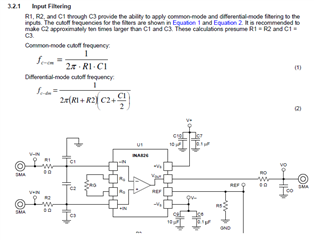Other Parts Discussed in Thread: OPA2343, TLV2333, OPA2333, OPA391
Hi Ti team,
Please help to check the schematic below?
1,Differential signal input

This thread has been locked.
If you have a related question, please click the "Ask a related question" button in the top right corner. The newly created question will be automatically linked to this question.
Hi Switch,
As Kai suggested, the design looks pretty good. Since I do not have your application requirements, I put together your circuit in Tina simulation and assumed the input is a Wheatstone bridge input application. The input differential voltage and input Vcm needs to follow the INA333's datasheet requirements.

INA333 Schematic Review 01122022.TSC
There may be several design considerations:
1. With Gain = 393 V/V, the BW of INA333 is at approx. 900Hz. You may or may not implement the differential and common mode filters. Regarding how to configure these filters, you may consult with the following application note.

2. The design should consider the input Vcm, Vout with the gain in order to operate in a linear region in INA333. You may also consult with the Analog Engineer's tool as shown below. Since I do not have your application requirements, I do not have guidance to suggest the optimum configuration.

https://www.ti.com/tool/ANALOG-ENGINEER-CALC
3. OPA2343 is not a precision Op Amp with low Vos voltage (Vos is in mV with up to 5MHz BW). Your circuit's output is low BW application. If the application requires low offset and precision op amps, you may consider OPA2333 or OPA391 parts. Of course, we have other low cost precision op amps as well, such as TLV2333 or many others.

If you have additional questions, please let us know.
Best,
Raymond